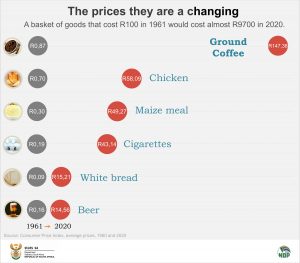Love it or hate it – the rand turns 60
While many couples will be celebrating Valentine’s Day this Sunday, 14 February, historians may have a different take on the day. 14 February 2021 is the 60th anniversary of the introduction of the rand as South Africa’s currency. Following the adoption of recommendations of the Decimal Coinage Commission in 1958, the British-styled pounds, shillings and pence were replaced by rands and cents at an exchange rate of approximately R2 = £1[i] in 1961.
Inflation as measured by the consumer price index is the key indicator of the changing value of money. South Africa has produced some form of consumer price index since at least 1895[ii]. Stats SA provides inflation figures back to 1911 on its website.[iii]
Between 1961 and 2020, prices increased by almost 97 times. What this means is that a basket of goods and services costing R100 in 1961 would have cost almost R9 700 in 2020.
In February 1961 annual inflation was 1,6%, and the average for the whole of 1961 was 1,9%. The 1960s was a period of generally low inflation, reaching a peak of 4,6% in November 1966. Inflation climbed during the 1970s and 1980s to reach its highest recorded level of 19,7% in September 1986. Annual inflation has averaged 8% in the period since the rand’s introduction.
The household fuel & light and transport categories were the main drivers of inflation in 1961, both registering annual rates of 3,5%. Food inflation was 2,1%, and clothing and footwear recorded no increase in 1961.
As Stats SA does today (most recent data is for December 2020)[iv], so the Bureau of Census and Statistics[v] published average prices of a range of consumer goods. This allows us to make some interesting comparisons! Although the currency went decimal in 1961, the imperial measurement system was still in operation until 1974. For simplicity a pound has been converted to 500g – although it is closer to 450g. Comparison is further complicated by changes in the quality and packaging format of goods.
So, how does the cost of things back then compare with today?
- A 1kg loaf of white bread (store baked) in 1961 cost 9c, compared with R15,21 for 700g (sliced).
- Mielie meal was available in a 5kg cotton bag for 30c – today an equivalent size costs R49,27.
- Fresh chicken cost 70c a kilogram compared with R58,09 in 2020.
- A 340g tin of corned beef went for 29c in 1961 and a smaller 300g tin cost R27,21 last year.
- A dozen large eggs was 34c in 1961 and is presently R37,60.
- Tomatoes could be bought for 20c/kg then, and now cost R20,74c/kg.
- Apples cost 23c/kg in 1961, and are currently R15,76/kg.
- Pure ground coffee was 87c for a 1 pound packet. Two 250g bags today will average R147,38.
- A pint (570ml) of beer was 16c – and you could return the bottle for a 2c refund! When it’s allowed, you can get a 330ml lager for R14,56 (no refund).
- Cigarettes were 19c for a pack of 20. They now average R43,14 for the same quantity.
So to all those newly-minted couples celebrating Valentine’s Day, may your love have the longevity of the rand – just keep it stronger.
[i] Rossouw, J, 2020, Diamond jubilee of decimalisation: 60 years of South African rand and cent,
Tydskrif vir Geesteswetenskappe, Jaargang 60 No. 3.
[ii] Union office of Census and Statistics, 1922, Official Year Book of the Union, government printing and stationery office.
[iii] https://www.statssa.gov.za/publications/P0141/CPIHistory.pdf?
[iv] https://www.statssa.gov.za/?page_id=1847
[v] Bureau of Census and Statistics, 1961, Retail prices of commodities and services, Special report No 254, The Government Printer



